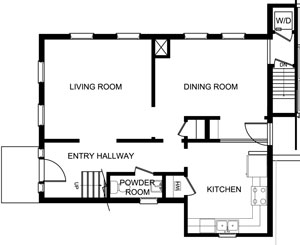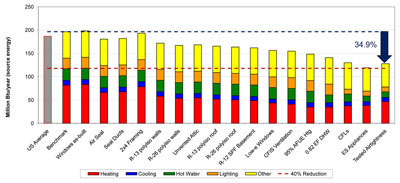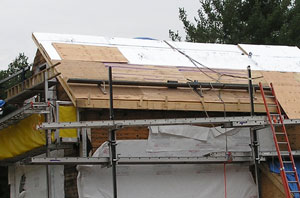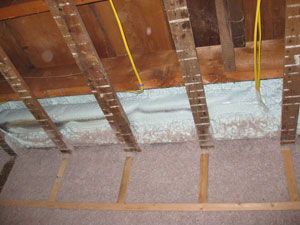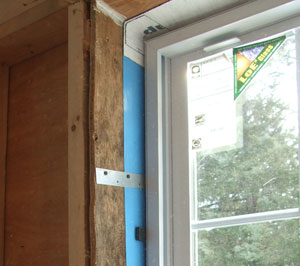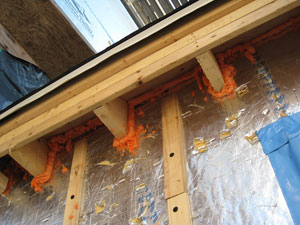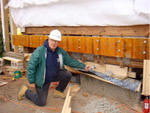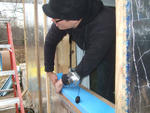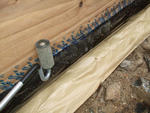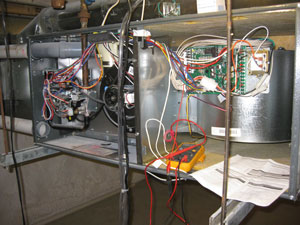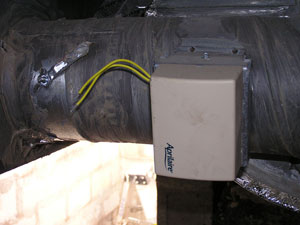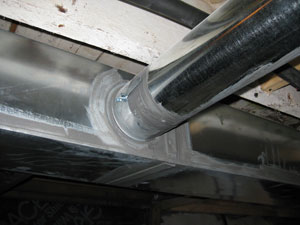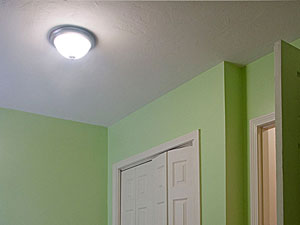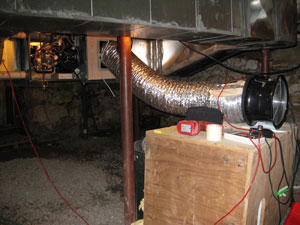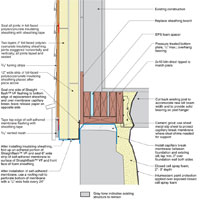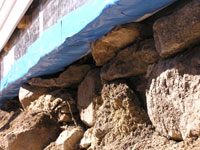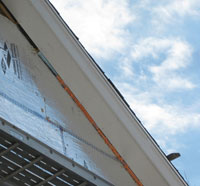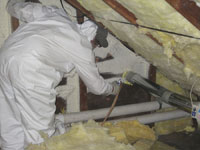Project Team: Habitat for Humanity of Greater Lowell, Shawsheen Technical High School, Building Science Corporation
Location: Bedford, Massachusetts
Description: 1,504 ft2 two-story three bedroom, one-and-a-half bath home
Completion Date: November 2009
Estimated Annual Energy Usage: 35% energy use reduction over the Building America benchmark; $930 estimated annual savings
Overview
Habitat for Humanity of Greater Lowell (HfHGL) has partnered with Building Science Corporation (BSC) on previous new construction projects. This working relationship continued with HfHGL’s renovation of a mid-19th century farmhouse into affordable housing meeting Building America performance standards. BSC guided the project through the compound challenges of implementing high performance construction in the context of Habitat’s construction process and in the context of a 150 year-old structure in an historic district.
BSC applied its 10-20-40-60 insulation performance guideline to the overall project plan. The guideline was met through installation of a new insulated slab, application of closed-cell spray foam insulation to the interior of the field stone foundation walls, and the addition of thick exterior insulation to the roof and wall assemblies. BSC developed details to achieve robust water management, maintain air and thermal barrier continuity, and respect the historic character of the property. The exterior of the insulating sheathing was designated to perform both as drainage plane and air barrier for the wall assembly. Comprehensive testing has evaluated the effectiveness of the air barrier system. Utility bill monitoring will provide further assessment of the overall efficacy of the high performance renovation.
Design
Habitat for Humanity of Greater Lowell (HfHGL) acquired control of a lot able to accommodate 7 new units of affordable housing. HfHGL decided to renovate the existing 1850’s-era farmhouse on the site as an additional affordable housing unit. Building Science Corporation, worked with HfHGL to develop plans to renovate the farmhouse to Building America performance levels.
The farmhouse had already been altered and adapted many times to suit the changing needs and means of occupants. Some of the additions were poorly constructed and were demolished. The building received new mechanical, plumbing and electrical systems. The kitchen and bathrooms were entirely remodeled. The interior was modestly reconfigured to accommodate 3 bedrooms and a full bathroom on the 2nd floor, closets for each bedroom, and laundry on the main level. Thermal enclosure improvements brought both the attic and basement inside conditioned space.
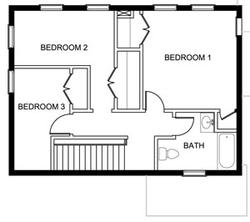
Second floor plan
This project demonstrates massive energy use reductions in a type and age of building that is widespread in the region. The project also demonstrates the application of specific high performance techniques to an older building. By respecting and maintaining the historic character of the building and elevating its aesthetics, the project also allays concerns that a high performance retrofit threatens the character and appeal of a neighborhood.
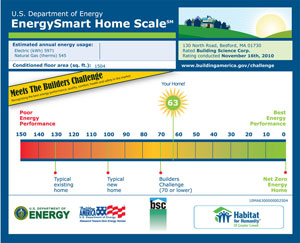
Builders Challenge Certificate
Enclosure Design
Roof Assembly: Rafter-framed unvented attic with R-56 roof insulation: unfaced fiberglass batt insulation (R-30) in rafter bay with two 2” layers of foil-faced polyisocyanurate insulating sheathing (R-26, joints staggered and taped) on top of existing/repaired roof sheathing.
Wall Assembly: Existing wall framing cavities filled with blown-in cellulose insulation (R-14). Spray foam insulation at critical transitions. Two 2” layers of rigid foil-faced polyisocyanurate insulation (R-26).
Window Specifications: Andersen Silverline double glazed, Low-E, vinyl windows: U=0.35, SHGC=0.29
Air Sealing: The primary air flow control layer is the exterior face of the insulating sheathing with taped seams. Self-adhered membrane and low expansion foam sealants transition the air flow control at windows. Self-adhered ice/water membrane over the entire surface of the roof sheathing provides air flow control at the roof. Low expansion foam is used to transition the air barrier to roof framing and sheathing. Self-adhered membrane flashings transition the air control layer at the base of the above grade wall to the closed-cell foam applied to the interior of the foundation walls.
Foundation Assembly: Conditioned basement with 2-3” closed-cell spray foam insulation applied directly to field stone foundation walls and covered with FireFree 88® ignition barrier paint. A 12” high strip of 2” XPS as the slab perimeter thermal break also allows foundation walls to drain to the sub-slab drainage system. Trenches filled with gravel and drainage pipe connected to a sump manage bulk water below a new concrete basement floor slab, 6 mil poly, 2” XPS and continuous bed of gravel.
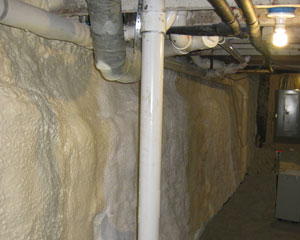
Closed-cell spray foam insulation
Construction
The Habitat for Humanity (HfH) Construction Supervisor is accustomed to the challenges of coordinating a rotating crew of volunteers and of tailoring the construction to make the best use of donated materials. This project faced the added challenges inherent in retrofitting a 150 year-old building in an historic district. Students in carpentry and plumbing programs at nearby Shawsheen Technical High School contributed significantly to the project.
Of significant benefit to the high performance goals, is the fact that the HfH Construction Supervisor had worked with BSC on a recently completed Building America project. Many of the techniques employed in this project are familiar to the builder.
As might be expect for a retrofit project, construction demolition revealed conditions have could not have been anticipated in the initial design. The BSC design and construction support team provided details and revised others in order to preserve performance objectives. In order to ensure the successful implementation of critical details, BSC was frequently on site to provide construction guidance. For example, BSC conducted a demonstration of the window sequence before crews installed windows. BSC used blower door and Duct Blaster® fans to guide air sealing and duct sealing prior to drywall installation BSC provided support through frequent communication with the site supervisor and subcontractors.
Mechanical Design
Heating: 96% AFUE sealed-combustion gas furnace with a MERV 13 filter. Furnace installed in conditioned space.
Ventilation: Central-fan-integrated supply (CFIS) ventilation with Aprilaire controller.
Space Conditioning Distribution: Air handler and distribution entirely within conditioned space. Sheet metal trunks and run-outs. Ducted return from first floor with transfer grilles above bedroom doors.
DHW:0.82 EF on demand gas water heater
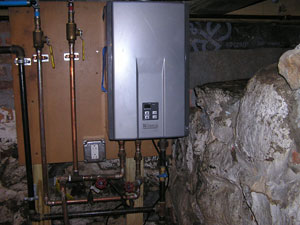
On demand gas domestic hot water
Lighting: 90% ENERGY STAR® CFLs
Appliances: ENERGY STAR® dishwasher, refrigerator and clothes washer
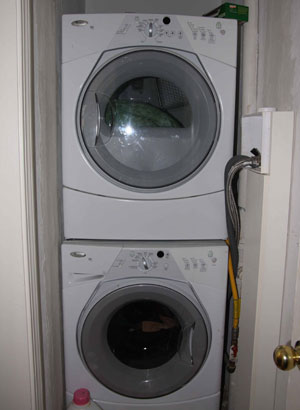
ENERGY STAR® clothes washer (bottom)
Testing
After the major construction had been completed but before the building was turned over to the residence, BSC conducted performance testing, including overall air infiltration (blower door), duct leakage (total and to exterior), HVAC system static pressure and overall flow, HVAC register flows, room pressurization, and ventilation system flows.
The total air distribution system leakage testing measured 285 cfm at 25 Pa. Testing found 50 cfm leakage to the outside. The total leakage measurement was higher than expected given that the HVAC installer had used mastic on joints and connections, and that duct pressurization was used to help volunteers and BSC staff locate and seal duct leakage. The fact that the distribution system had been reconfigured during the course of the project undoubtedly affected duct leakage.
Initial whole-building air tightness measurements were disappointing. BSC’s initial guarded leakage measurement was 2560 cfm50 corresponding to 5.1 in2 per 100 ft2 of enclosure or 9 ACH50. A team of BSC engineers and technicians conducted intensive air barrier remediation and achieved a 32% reduction in total leakage. The resulting guarded leakage is estimated at 3.6 in2/100 ft2 or just under 5 ACH50. The end results fell short of the Building America target for new homes but were deemed a significantly positive achievement for this retrofit situation.
Moving Forward
Through this project, Habitat for Humanity of Greater Lowell has demonstrated that a high performance housing is achievable even in the face of the triple challenge of retrofit, affordable housing, and volunteer labor. The projected energy performance represents a significant improvement relative to typical US housing stock and compared to code-built new construction built by building professionals.
BSC developed many construction details to allow this project to achieve its high performance objects. Through the challenges of implementing an effective air barrier, BSC has identified more robust, less workmanship-dependent systems to ease the achievement of high performance on successive projects.
Design Challenge: Air Leakage Control Initial plans for this project called for air leakage control of the wall assembly to be accomplished by a carefully detailed housewrap layer applied over the existing sheathing after removal of the existing cladding. During the course of several protracted project delays, this housewrap layer became severely damaged. Rather than remove and re-apply a housewrap air barrier, BSC and HfHGL decided to implement the air barrier at the exterior face of insulating sheathing. BSC developed details to resolve complex air barrier transitions at the base of the wall, windows, mechanical penetrations, and at roof-wall transitions. Visual inspection as well as blower-door assisted air barrier remediation demonstrated that the air leakage control strategy is highly dependent upon workmanship, project schedule, and timing. While it certainly is possible to achieve effective air leakage control at the exterior face of insulating sheathing, it is likely that air leakage control systems implemented at the face of existing sheathing will be more readily feasible for retrofit situations. |

